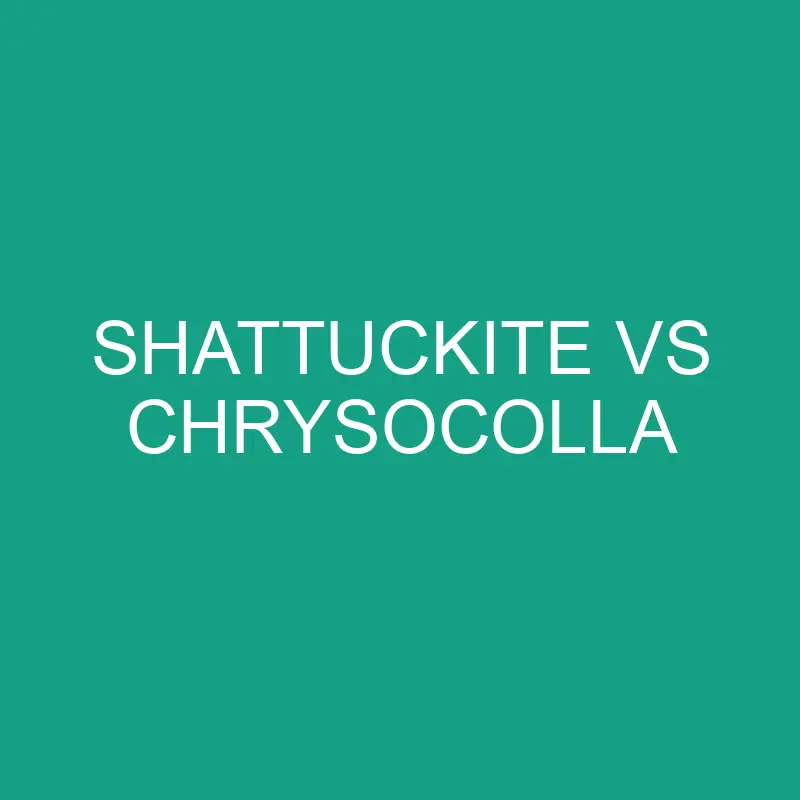Navigating the Turquoise Hues of Two Captivating Minerals
In the vast palette of gemstones, the serene turquoise hues hold a special allure, conveying a sense of calmness and connection to nature. Shattuckite and Chrysocolla, two minerals sharing this enchanting color, are often interrelated due to their similar appearance, but they possess distinct properties, origins, and uses. In this exploration, we will delve into the world of Shattuckite and Chrysocolla, unraveling the mysteries behind these captivating turquoise minerals.
Post Contents
Shattuckite: The Elegance of Azure Blue
Origins and Geological Background:
- Composition: Shattuckite is a copper silicate mineral that often forms in association with other copper minerals.
- Formation: It is typically found in the oxidation zones of copper deposits, often in association with malachite, azurite, and chrysocolla.
Physical Properties:
- Color and Appearance: Shattuckite exhibits a distinctive azure blue to greenish-blue color, often with a silky luster. It can form as compact aggregates or in needle-like crystals.
- Transparency: Typically opaque.
- Crystal Structure: Shattuckite crystallizes in the orthorhombic system, forming prismatic crystals.
Origins and Mining:
- Locations: Shattuckite is found in various locations worldwide, with notable occurrences in Namibia, the Congo, and the southwestern United States.
- Mining: Extracted through mining operations, Shattuckite is valued for its use in jewelry and as a collector’s mineral.
Metaphysical Properties:
- Communication and Intuition: Shattuckite is associated with enhancing communication skills and promoting intuition. It is believed to help with expressing one’s thoughts and feelings.
- Throat Chakra Activation: It is often linked to the throat chakra, fostering clear and effective communication.
Uses in Jewelry and Art:
- Jewelry: Shattuckite, with its captivating blue hue, is occasionally used in jewelry, especially in the creation of unique and artisan pieces.
- Carvings and Collectibles: Larger specimens of Shattuckite, featuring its distinctive crystal forms, are prized by collectors and may be used in carvings and decorative items.
Chrysocolla: The Tranquil Beauty of Nature’s Palette
Origins and Geological Background:
- Composition: Chrysocolla is a hydrated copper silicate mineral and is often found as a secondary mineral in copper deposits.
- Formation: It forms in the oxidation zones of copper ore bodies and is commonly associated with other copper minerals like malachite, azurite, and cuprite.
Physical Properties:
- Color and Appearance: Chrysocolla displays a range of colors from light green to deep blue and turquoise. It often forms in botryoidal (grape-like) or massive aggregates and can have a vibrant, earthy appearance.
- Transparency: Typically opaque.
- Crystal Structure: Chrysocolla does not have a well-defined crystal structure and is often found in amorphous masses.
Origins and Mining:
- Locations: Chrysocolla is found in various locations globally, with significant deposits in the southwestern United States, Chile, Peru, and the Democratic Republic of the Congo.
- Mining: Extracted through mining operations, Chrysocolla is used for both ornamental purposes and in jewelry.
Metaphysical Properties:
- Empowerment and Calming: Chrysocolla is associated with promoting empowerment and tranquility. It is believed to soothe and calm, making it a stone for emotional balance.
- Throat and Heart Chakra Alignment: Chrysocolla is often linked to both the throat and heart chakras, encouraging truthful expression and fostering compassion.
Uses in Jewelry and Art:
- Jewelry: Chrysocolla is a popular choice in jewelry, especially for its vibrant turquoise hues. It is often cut into cabochons, beads, or used in its natural, rough form.
- Carvings and Sculptures: Larger specimens of Chrysocolla, with its captivating patterns and colors, may be carved into sculptures or used in ornamental items.
Comparative Analysis: Shattuckite vs. Chrysocolla
1. Color and Appearance:
- Shattuckite: Exhibits an azure blue to greenish-blue color, often with a silky luster. Forms in compact aggregates or needle-like crystals.
- Chrysocolla: Displays a range of colors from light green to deep blue and turquoise. Often forms in botryoidal or massive aggregates with an earthy appearance.
2. Transparency:
- Shattuckite: Typically opaque.
- Chrysocolla: Typically opaque.
3. Crystal Structure:
- Shattuckite: Crystallizes in the orthorhombic system, forming prismatic crystals.
- Chrysocolla: Does not have a well-defined crystal structure and is often found in amorphous masses.
4. Origins and Mining:
- Shattuckite: Found in various locations, including Namibia, the Congo, and the southwestern United States.
- Chrysocolla: Found globally, with significant deposits in the southwestern United States, Chile, Peru, and the Democratic Republic of the Congo.
5. Metaphysical Properties:
- Shattuckite: Associated with communication skills, intuition, and throat chakra activation.
- Chrysocolla: Associated with empowerment, tranquility, and alignment of the throat and heart chakras.
6. Uses in Art:
- Shattuckite: Used in jewelry and occasionally in carvings and decorative items.
- Chrysocolla: Widely used in jewelry, often cut into cabochons, beads, or used in its natural, rough form. Also used in carvings and sculptures.
In the realm of turquoise-hued minerals, Shattuckite and Chrysocolla stand as distinct expressions of nature’s artistic palette. While Shattuckite captivates with its azure blue elegance and associations with communication, Chrysocolla enchants with its range of colors and tranquil beauty, embodying empowerment and emotional balance. The choice between Shattuckite and Chrysocolla is a matter of personal resonance, whether one is drawn to the refined blue of Shattuckite or the vibrant, earthy tones of Chrysocolla. Both minerals invite individuals to navigate the turquoise realm, adding a touch of nature’s artistry to their jewelry collections and metaphysical practices.
